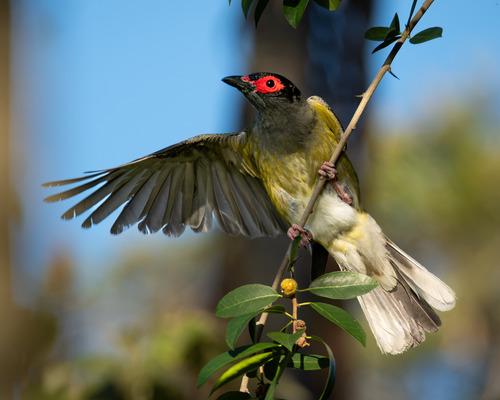
Australasian Figbird
The Australasian Figbird (*Sphecotheres vieilloti*) is a vibrant and ecologically significant bird species found in northern and eastern Australia, as well as parts of New Guinea. Known for their striking sexual dimorphism, with males displaying bright yellow underparts and a distinctive red eye-ring, figbirds play a crucial role in seed dispersal for various rainforest and woodland trees, particularly figs, as their name suggests. They are highly social birds, often seen in noisy flocks, and are a familiar sight in many urban and suburban areas within their range. Their loud, distinctive calls are a characteristic sound of the Australian bush.
27-29.5 cm
Length
Unknown cm
Wingspan
Least Concern
Conservation Status
Distribution
The Australasian Figbird is found along the northern and eastern coasts of Australia, extending from the Kimberley region in Western Australia, through the Top End and Queensland, down to southern New South Wales. They are also found in eastern Indonesia, southern and eastern New Guinea and surrounding islands.
Lifespan
Unknown, but likely several years in the wild.
Australasian Figbird's Habitat
Habitat Types
Rainforests, Woodlands, Mangrove forests, Urban parks and gardens, Eucalypt forests
Climate Zones
Tropical, Subtropical, Temperate (in the southern part of their range)
Adaptations
Figbirds are well-adapted to arboreal life, with strong feet for perching and gripping branches. Their relatively short, stout bill is suited for consuming soft fruits. Their ability to thrive in a variety of habitats, including human-modified landscapes, highlights their adaptability.
Variations
Several subspecies are recognized, differing slightly in plumage and size. For example, *S. v. salvadorii*, found in southeastern New Guinea, has a more extensive black cap in males. The subspecies *S. v. ashbyi* is found in the Kimberley region.
Appearance
Breeding Plumage
Minimal difference; plumage is relatively consistent year-round.
Seasonal Feather Changes
None
Sex Based Plumage Differences
Pronounced. Males have bright yellow underparts, olive-green upperparts, a black head, and a conspicuous red, bare skin patch around the eye. Females are duller, with greyish-brown upperparts, streaked underparts, and a greyish eye-ring.
Notable Features
Bright red eye-ring in males (grey in females), Black head in males (grey in females), Strong, slightly curved bill
Diet and Feeding
Primary Foods
Fruits (especially figs), Berries, Insects, Nectar
Foraging Behavior
Figbirds are primarily frugivorous, foraging in the canopy and middle levels of trees. They often feed in noisy flocks, moving actively through the foliage. They will also glean insects from leaves and branches, and occasionally take nectar from flowers.
Specializations
Their bill is adapted for handling soft fruits, and their digestive system is efficient at processing the sugars and nutrients from fruit.
Seasonal Diet Variations
The proportion of fruit and insects in their diet may vary depending on seasonal availability. Fruit availability is generally high year-round in their tropical and subtropical habitats.
Behavior
Social Structure
Highly social; often found in flocks of up to 20 or more birds, especially outside the breeding season. They can form mixed-species flocks with other frugivores.
Communication
Loud, distinctive 'koo-wee-oo' calls, Chattering and scolding calls, Visual displays (e.g., wing-spreading during courtship)
Migration
Generally resident (non-migratory), but some local movements may occur in response to food availability.
Territorial or Group Behaviors
During the breeding season, pairs may defend a small territory around their nest. Outside the breeding season, they are highly gregarious and non-territorial.
Conservation
Threats
Habitat loss and fragmentation (although they are relatively adaptable), Competition with introduced species (e.g., Common Myna, though impact is likely minimal)
Protection Programs
Not currently subject to specific conservation programs due to their 'Least Concern' status.
Local National Laws
Protected under general wildlife legislation in Australia.
Population Trend
Stable
Population Estimates
Not Evaluated, but considered common and widespread.
Interesting Facts
They are important seed dispersers.
By consuming fruits and excreting the seeds in different locations, they help maintain the health and diversity of rainforest and woodland ecosystems.
Their scientific name, *Sphecotheres*, means 'wasp-hunter'.
Although they primarily eat fruit, they will also take insects, including wasps.
They are sometimes mistaken for orioles.
While they are in the same family (Oriolidae), figbirds have distinct plumage and a more robust build than typical orioles.
Juveniles resemble females.
Young birds of both sexes have the duller, streaked plumage of the adult female, acquiring their adult plumage as they mature.
Faqs about Australasian Figbird
What is the difference between a male and female Australasian Figbird?
Males have bright yellow underparts, olive-green upperparts, a black head, and a red eye-ring. Females are duller, with grey-brown upperparts, streaked underparts, and a grey eye-ring.
Are Australasian Figbirds aggressive?
They are not generally aggressive towards humans. They can be noisy and boisterous, especially in flocks, but they are not known to attack people.
Do Australasian Figbirds migrate?
They are mostly resident, meaning they don't undertake long-distance migrations. However, they may move locally in response to fruit availability.
What should I do if I find a baby Figbird?
If you find a baby bird that appears to be injured or abandoned, it's best to contact a local wildlife rescue organization for advice. Consult a professional for expert advice.
Copyright @ Nature Style Limited. All Rights Reserved.
 English
English